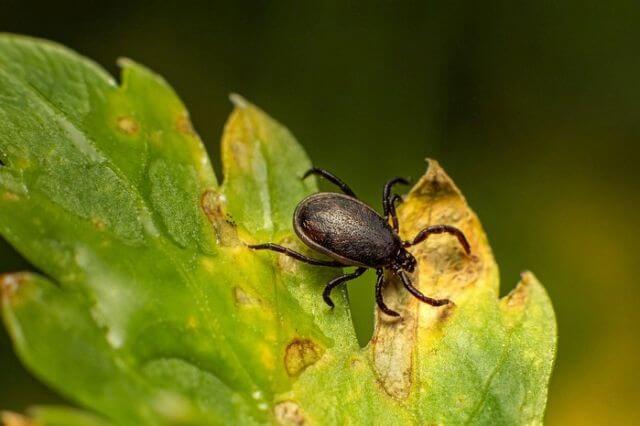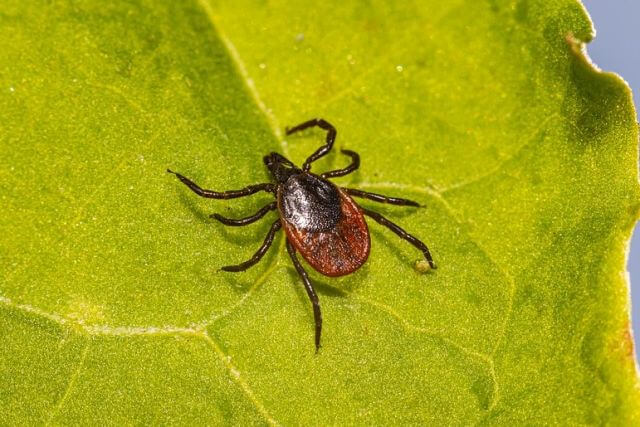The deer tick, also known as the blackleg tick (Ixodes scapularis), is a small arachnid of the Ixodidae family. It is a common species of tick found in various parts of North America, particularly in wooded and grassy areas. The name “deer tick” comes from the common association with deer, as these ticks are commonly found on deer and other large mammals.
The larvae and nymphs primarily feed on small animals and birds, while the adult ticks prefer larger hosts like deer, rodents, and other mammals, including humans.
It is a small tick with a flattened oval-shaped body, adults are typically about 2-3 mm in length, while fully engorged females can reach up to 10 mm. They are dark brown to reddish-brown in color and have distinctive black legs, which is why they are also called “black-legged ticks.”
How Big Is A Deer Tick
Deer ticks a larva is barely the size of a poppy seed, they are difficult to see. The adult deer tick reaches about 3 mm in length, just s big as in sesame seeds. It has a dark brown to black color. Both nymphs and adults have eight large, black-color legs that stretch from a circular, bulb-shaped abdomen.
What Does A Deer Tick Look Like?
The adult ticks show a clearly visible difference between males and females.

In male ticks, the shield, which covers the entire body of the male, is dark, almost black in color with a white band around the abdomen.

In the female, as in other tick species, the shield only covers the front part of the body. The protruding rear part of the body is orange to reddish in color. A Female’s torso may also change to more brown-colored after being engorged with blood.
Although, the shape of a black-legged arachnid tends to be flat. It fills up and expands after eating.
Where Do Deer Ticks Live?
Blacklegged ticks are mainly seen in the eastern half of the United States. The northern extent of the tick also covers parts of southern Canada.
They are often found in wooded regions and forest grasses and are more prevalent around buildings and homes in rural or secluded regions. Unlike the brown dog tick, this class is seldom seen indoors unless found on cats or dogs.
Reproduction and Life Cycle
Blacklegged ticks go through three (four if you count the egg stage) stages of a life cycle: egg, the 6-legs larva, 8-legs nymph, and adult.
It needs a blood meal in each stage. In the last stage as an adult tick, the females take so much blood from the host it can multiply 50 to 100 times its own weight. Then they lay their eggs and perish. The Blacklegged tick has around a two-year life cycle.
Young ticks (larvae and nymphs) possess an extensive host range, like lagomorphs, birds, insectivores, rodents, and ungulates. In contrast, adults are limited to medium and big-sized creatures, usually white-tailed deer.
Which diseases do they carry?
Deer ticks can transmit various diseases depending on the bacteria they store in their bodies when they latch upon a different host.
Do All Deer Ticks Carry Lyme Disease?
As per the CDC (Centers for Disease Prevention and Control), Lyme disease is the most frequent tick-borne disease in the United States. Depending on the geographical occurrence, up to 50% of deer ticks carry Lyme borreliosis. (source)
The infection spreads mainly through black-legged tick bites. Infected arachnids can carry on the bacteria that produce it, such as Borrelia mayonii and Borrelia burgdorferi.
Most cases of Lyme disease are curable with some weeks of medicines. Without treatment, the infection may progress to the human heart, joints, and nervous system.
Other infectious diseases
Blacklegged ticks may also transmit other serious diseases, including Ehrlichiosis, Anaplasmosis, Powassan virus disease, Babesiosis, and Borrelia miyamotoi disease.
What are deer tick bite symptoms?
Deer tick bites are generally harmless and may provide no symptoms unless the bit becomes infected. The real problem with deer tick bites is the high likelihood of dangerous disease transmission. However, possible symptoms of tick-borne infections include:
- a red spot or rash near the bit place
- neck stiffness
- nausea
- weakness
- a headache
- a fever
- muscle or joint pain
- swollen lymph nodes
Be sure to look for medical care asap if any symptoms occur when bitten by a deer tick.
What Does A Deer Tick Bite Look Like?
When the tick is in the wound, you can see a tiny foreign body that seems attached/burrowed into the skin. Sometimes a slight reddening can be seen around the wound. A magnifying glass helps to examine the cause more closely.
The bite is painless you don’t feel anything. These ticks discharge a kind of anesthetic with their saliva. It enables them to feast on you without feeling the bite’s pain. Frequently inspecting the body for deer ticks is the most obvious way to recognize a tick bite.
Ticks prefer to bite in areas where the skin is soft and they are hard to see, like the underarms, groin, or other skin wrinkles. The bite may seem brown or purple on tan skin or red on pale skin.
How to avoid deer ticks?
If possible, avoid sites where these ticks exist, including thick and big grasses, forest regions, and areas known to possess mammal wildlife.
Try to walk in the track’s center when stepping on these areas and avoid brushing upon the greenery. These arachnids will usually wait on the plant’s tip to latch onto a human or animal walking by.
How to get personal protection?
For personal protection, it is essential for you to wear clothing that offers complete coverage — such as long-sleeved shirts, long socks, and pants — while camping, hiking, or walking in a range known to possess black-legged ticks.
Even after a tour, it is essential to verify clothing, all gears, and pets. You can use a mirror to check difficult-to-reach areas. Watch over the whole body to check for an arachnid, giving special attention to the below locations:
- under the arms
- behind the knees
- inside the belly button
- between the legs
- on the scalp or near the hairline
- around the groin
- around the waist
- around the ears
What Stops Deer Ticks?
If you live in an area where black-legged ticks are common, you should try to make your surroundings less favorable to deer ticks and host animals. The easiest way to achieve this is to keep your yard clean and tidy.
Some prevention tips include:
- trimming lawns and keeping them low
- eliminating weeds and thick brush
- keeping trash bins tightly closed to restrain creatures that may bring ticks, such as mice and raccoons
- removing leaf litter
Treatments for a deer tick bite
If you see a tick on your skin, take immediate action to remove it. Use a tick removal tool to properly pull the tick out of the skin without breaking any parts that may remain in the wound.
If parts remain in the skin it is usually the mouthparts. Usually, the body rejects them within a few days. Trying to remove these parts could only enlarge the wound and allow dirt to get in.
After removal, clean the wound, disinfect with rubbing alcohol and observe for a few days.
Place the tick in a small glass jar, label it and keep in the freezer. If you get sick, this can help the doctor determine the type of tick and check for pathogens.
When to see a doctor
If a tick has bitten you, it is good to do a complete-body check-up to see if there are any more ticks.
Consulting a doctor is essential if you develop a fever, a rash, or other symptoms in the weeks after a tick bite. Those indications are linked with several diseases transmitted by ticks.
Furthermore, it can help create notes about the bite, like when it happened and any signs after the bite. Taking photos of the bite or the tick itself may also help a doctor know the type and the critical health dangers joined with it.
Help Protect Your Pets and Your Family
When the tick period is at its peak, during the warm summer months you should use a good tick repellent regularly to reduce the risk of tick bites and their unpleasant consequences.
Also, a regular daily check of your body can help to find any new tick bites or find the tick even before it had a chance to bite you.
You can use various ways to get rid of and restrict ticks on your felines and dogs. These options include oral medications, spot-on treatments, and tick collars.
There is also a shampoo comprising medicated elements you can utilize to bathe your furry friends and remove ticks on contact. Consult your vet, who can assist you in determining the best choice for you and your pet.
More



